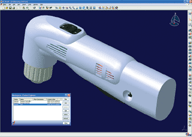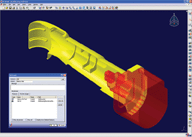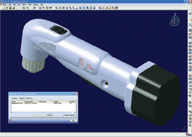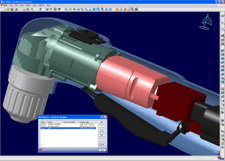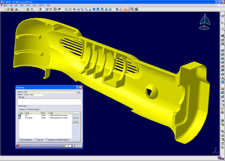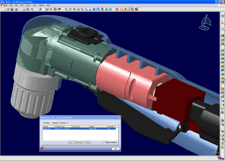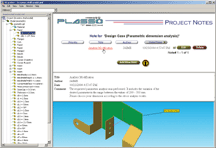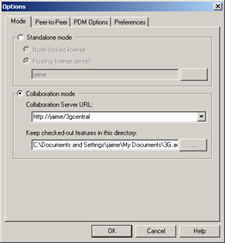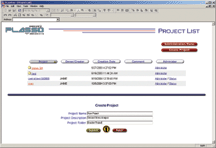Technology Helps Peers Work Together
Embedded collaboration tools like ImpactXoft's IX SPeeD CAD and PlassoTech's 3G.author CAE programs represent the future of engineering communication.
Latest News
December 1, 2004
By Louise Elliott
Engineers used to be able to work together simply by walking down a hall from one office or cubicle to another. If a design engineer needed to work out a problem raised by manufacturing, he just went down to the shop floor. Ah, the good old days.
Things have changed. Companies have grown, been acquired or acquired others, have multiple locations, and outsource their manufacturing. At the same time, management wants to shrink the time from concept to production and aims for engineering to become as concurrent as possible. But nowadays engineers may be working across the country or across the globe from each other—so working together has become collaboration.
Most asynchronous collaborative engineering tools now available employ PDM-based PLM technologies, mostly view and markup tools, where engineers work with visualizations and then have to address changes individually on their own desktop platforms. Web-based synchronous collaboration mostly gets used for design review.
Two companies in different but related spheres of engineering, however, offer a rich set of tools that enable collaborative action within the engineering programs. ImpactXoft (IX) offers its collaborative tools with its stand-alone version IX SPeeD. (Dassault Systemes provides its CATIA CAD, starting with recently released Rev. 14, with IX technology embedded in it as an option.) PlassoTech, developers of 3G.author design analysis software, offers built-in collaboration tools for people performing analyses.
Scenario 1: |
|
The mechanical engineer’s model as he or she joins a |
|
The plastic engineer’s model as he or she shares a single |
|
The mechanical engineer’s model in IX after simply merging the Pull feature. |
Gian Paolo Bassi, VP and chief technical officer for ImpactXoft, describes its collaborative tools as “pure peer-to-peer collaboration that doesn’t use peer-to-peer architecture.”
For anyone not familiar with the terminology, peer-to-peer (P2P) architecture refers to a network in which each workstation has equivalent capabilities and responsibilities. This contrasts with client/server architecture, in which some computers are dedicated to serving the others. Both approaches are effective, but whereas P2P setups are simpler, they can’t handle as much data under heavy loads.
IX is client/server based, but differs from other systems, Bassi says, in a number of ways. “Collaboration usually means one of two categories of capability—a portal-based view and markup system or a database-sharing mechanism, such as PDM. If the latter is a client/server application, it can either share remote databases or instantly synchronize with a database—an approach that’s used a lot in electronic design,” he says.
Scenario 2: | |
| |
The mechanical engineer’s model as he or she joins a collaborative workspace. | |
| |
The plastic engineer’s model as he or she shares a single entity—a Rib functional feature. | |
| |
The mechanical engineer’s model after simply merging the Rib feature. | |
In contrast, he says, IX is focused upon “the object level of design activities.” That means that designers can collaborate at whatever design level they need. “This can be at the level of lines in an initial design, to subassemblies and full assemblies. We give them fully granular collaboration in what they really care about,” Bassi says. To accomplish this, IX provides a direct exchange of design elements that do not depend on a unique database or upon sets of files. One designer simply sends a packet of design data (NURBS data) to another. “This can be broadcast to peers or uploaded to a database,” he says. “The toolbar on the desktop has two very important buttons, Share and Merge.” Share sends a design packet; Merge opens it and merges it with the design on the recipient’s desktop. This is instant messaging with serious intent, because when the recipient clicks on Merge, the packet opens in his own design environment, so that he can see the effects of the changes immediately. These tools can be used by design engineers working on different parts or subassemblies of the same project—or may be used by such different disciplines as designers, industrial engineers, and manufacturing engineers who need to work together. Bassi says, “The system uses a collaboration server that we call a broker, because it brokers information among different people and groups.” It also uses standard Web services, and IBM messaging technology. “We’re not concerned with the mechanics of communication,” he says, “just with how the information is used and merged. All communication works like e-mail that can go from individual to individual, or be centralized in a bigger organization that posts the information on the server for the appropriate recipient to access for the next step in the process.” Because IX software is still so new, the only available comment comes from Black and Decker Corp., Baltimore, Maryland, which tested the system prior to its inclusion in CATIA. “This form of collaboration…enables a 24-hour work and communication day,” says Patti Terry, CAD Support manager. (For more details on Black and Decker’s use of ImpactXoft’s IX SPeeD, see the print edition of Louise Elliott’s “Recipe for Flexible Design Collaboration,” DE, February 2004.)
The users of PlassoTech’s 3G.suite have somewhat different needs from those of CAD users. The suite consists of a design analysis system, 3G.author; a collaborative hub, 3G.central; and a view and markup tool that also enables results verification and design optimization, 3G.access. Finite element analysis (FEA) produces much larger files than CAD does, and thus needs more storage space. The collaborative core of the system, 3G.central, “is a web-based repository that can be accessed by local or remote workgroups using http and https (secure) tools,” says Tomi Mossessian, CEO of PlassoTech. “All data for collaboration starts there. Users can configure different directories for various people, groups, and departments.” Users can read and write, using 3G.author, or read only, using 3G.access, with tools for markup. An architectural wrinkle, however, occurs because 3G.author can access just about every available CAD system (depending on the specific modeling kernels users want available) and can access the CAD systems over a peer-to-peer network.
|
Figure 1: This image shows a collaboration notification in the middle of an analysis. |
Feedback and notification use a number of different mechanisms. Markups and notifications to a team can go through e-mail, as can notices when someone wants to change a design, see a new analysis result, or make changes to loads (see Figure 1, above). “Suppose one person works on thermal analysis for a design,” says Mossessian. “At the same time, someone else is working on structural analysis of the same design. When the first person checks the design out of a file, he controls it for thermal analysis only, leaving a copy for his colleague who can access it for structural analysis only. Everyone else with authorization can check the latest results, but cannot change the design or results.” The check-in/check-out capability is completely independent of location. Users do their work and publish the results back to the repository.
Non-FEA users can check results in 3G.access and communicate back to the engineering teams. In addition to making analysis information available to the extended enterprise, the collaborative tools can communicate with suppliers, customers, and even form the core of communication between engineering professors in colleges and their analysis students.
| |
Figure 2: The 3G.author dialog box shows how you can indicate the site address in order to access 3G.central. | |
| |
Figure 3: Another 3G.author dialog box shows a web-based image of 3G.central project directory viewed from 3G.author. |
The stand-alone mode of 3G.author can be changed to collaborative simply by assigning a website address in a drop-down menu under the Options menu (see Figure 2, left). The user then restarts the computer, and the program reopens in collaborative mode.
3G.central has proven to be popular in large 3G.author installations in Japan. For example, Akebono Corp., a worldwide supplier of automotive brake systems, uses 3G.central “to share and access FEA data securely, and perform design reviews from different locations,” says Minoru Kanja, product marketing manager for PlassoTech’s large Japanese reseller, Kusco.
Unusual Yet Prophetic Commonalties
ImpactXoft’s IX SPeeD and PlassoTech’s 3G.author systems seem different on the surface and, indeed, they focus on related yet distinctly different aspects of the design process. But both enable extremely direct engineer-to-engineer communication, as well as communication with other departments.
Since partnering with Dassault Systemes, ImpactXoft has changed the modeling kernel used for its stand-alone CAD program from ACIS to CAA V5. The first release of the software built on that platform will be announced shortly.
In the past, the company partnered in Japan with Toyota Caelum, and has agreed that Toyota Caelum should continue to develop and market its ACIS-based Japanese version, called XXEN (pronounced Zen). Last summer, Toyota Caelum and PlassoTech agreed on a partnership in which 3G.author will be integrated with XXEN.
But the most in-common characteristic that the two systems share is the hitherto unusual, but probably prophetic, concept of creating engineering applications with a collaborative backbone built directly into the application.
Contributing editor Louise Elliott is a freelance writer based in California. Offer Louise your feedback on this article through [email protected].
Company Information
IX SPeeD
ImpactXoft USA
San Jose, CA
impactxoft.com
3G.author
PlassoTech, Inc.
Encino, CA
plassotech.com
Subscribe to our FREE magazine, FREE email newsletters or both!
Latest News
About the Author
DE’s editors contribute news and new product announcements to Digital Engineering.
Press releases may be sent to them via [email protected].







